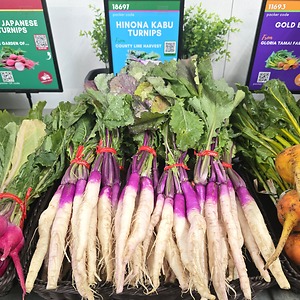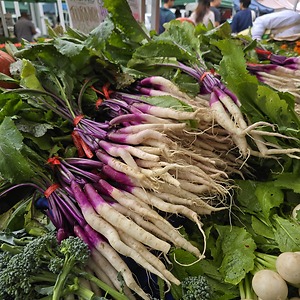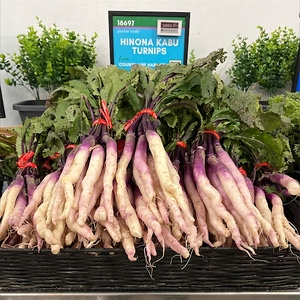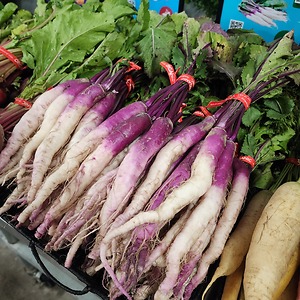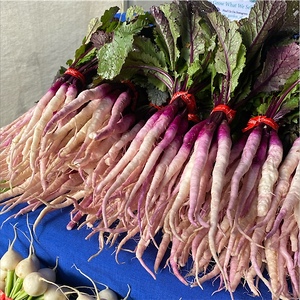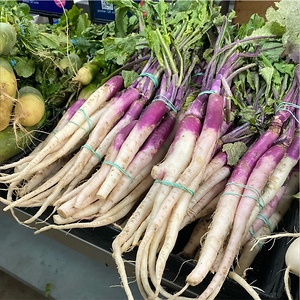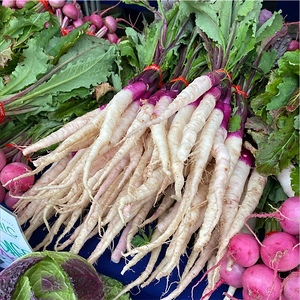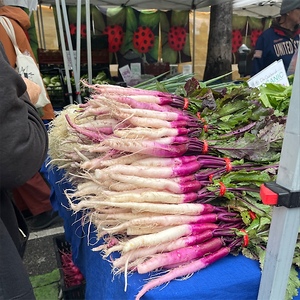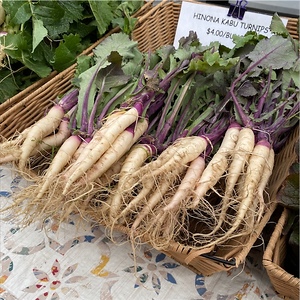


Hinona Kabu Turnips
Estimated Inventory, bunch : 0
This item was last sold on : 03/11/25
Description/Taste
Hinona Kabu turnips are slender, medium to large roots, averaging 25 to 30 centimeters in length, and have a thin, long, and slightly tapered, cylindrical shape, appearing straight or curved depending on the soil. The root’s skin is thin, semi-smooth, and firm, covered in fine white root hairs. The turnips also display violet to red-purple shoulders at the top of the root, transitioning into a bright white hue at the base. It is important to note that the color of the roots will vary depending on the time of year and climate. Underneath the bi-colored skin, the flesh is dense, white, and lightly aqueous with a crisp and crunchy consistency. Hinona Kabu turnips have a mild, sweet, and peppery flavor with earthy undertones. In addition to the roots, the tall dark green and purple leaves are edible, contributing spicy, vegetal, and grassy flavors.
Seasons/Availability
Hinona Kabu turnips are available year-round, with a peak season in the mid-fall through early winter.
Current Facts
Hinona Kabu turnips, botanically classified as Brassica rapa var. rapifera, are an heirloom variety belonging to the Brassicaceae family. The Japanese turnips are favored for their long and slender, colorful appearance, crisp texture, and mild, peppery flavor. Hinona Kabu turnips are known by several names, including Long turnip, Turnip of the Sun, Kabu, Hi-Nona, Akana, Ebi-Na, and Mo Ching. The crunchy roots are versatile in culinary preparations, utilized raw for added texture, cooked as a filling ingredient, or pickled as a tangy, chewy condiment. Hinona Kabu turnips are commercially cultivated throughout Japan, but outside of the country, the roots are rare and reserved to being grown by specialty farms and home gardens.
Nutritional Value
Hinona Kabu turnips, like other turnip varieties, are a good source of vitamin C to strengthen the immune system, vitamin K to assist in faster wound healing, vitamin A to maintain healthy organ functioning, and contain calcium, iron, manganese, folate, and potassium. Beyond the roots, the leaves also provide potassium to balance fluid levels within the body, calcium to protect bones and teeth, and vitamin C to reduce inflammation.
Applications
Hinona Kabu turnips have a sweet and peppery flavor well suited for raw or cooked preparations. The slender roots can be washed, removing the fine root hairs, and sliced for salads, coleslaws, and grain bowls. The skin can be peeled or left intact, depending on preference, and the roots can also be incorporated into soups, curries, and stews, caramelized in soy sauce, butter, and sugar as a rich side dish, stir-fried with other vegetables, or roasted or sauteed as an accompaniment to meats. Hinona Kabu turnips can be utilized in any recipe calling for common turnips. In Japan, Hinona Kabu turnips are popularly peeled and pickled in a dish known as sakura-zuke. Sakura translates to “cherry blossom” in Japanese and is a descriptor given for the pickled turnip’s pink hue. Zuke means “pickle,” and the tangy, crisp, and sweet pickled radishes are served as a condiment, snack, or side dish to sushi. In addition to the roots, the turnip leaves are also edible and can be lightly steamed or sauteed as an earthy, spicy, and vegetal green. Hinona Kabu turnips pair well with other root vegetables, fennel, asparagus, aromatics including garlic, shallots, ginger, and onions, parsley, miso, lemon, yuzu, and strawberries. Whole, unwashed roots will keep 1 to 2 weeks when wrapped in newspaper and stored in the refrigerator. The leaves should be separated from the root so the root does not dry out. Cooked Hinona Kabu turnips will keep for a couple of days when stored in a sealed container in the fridge. The leaves and roots can also be frozen for extended use.
Ethnic/Cultural Info
In Japan, pickled vegetables, also known as tsukemono, are a traditional component of meals, favored for their sweet, sour, and tangy flavor. Historically, pickling was a preservation method in Japan, and many different types of vegetables could be preserved in vinegar or salt. Hinona Kabu turnips are a favored pickled vegetable, and the slender roots contain a bi-colored red-purple and white hue, a color combination that symbolizes happiness in Japan. Red and white represent a mix of strength, energy, purity, and truth, and it is common for culinary dishes to include the color combination in celebratory dishes for birthdays, weddings, and national holidays. Smaller Hinona Kabu turnips are frequently left whole in Japanese dishes to accentuate the color contrast, and the sliced pickled turnips also develop a magenta hue, valued as an aesthetically pleasing condiment for raw fish and rice. Legend has it that the pink pickled turnips were once a gift to Emperor Kashiwabara, who later wrote about the pickles in a poem sometime during the 16th century.
Geography/History
Hinona Kabu turnips are believed by experts to have originated in Japan. There are several theories as to when the roots were first discovered, with the primary belief that the turnips date back to the 1470s. Lord Gamou Sadahid, the creator of the Otowa Castle, was rumored to have discovered the turnips growing in Hino, a town within the Shiga prefecture. The second theory connects Hinona Kabu turnips to long red tankard turnips, a popular European variety during the 1800s. Some experts believe Hinona Kabu turnips were a natural cross created from a long red tankard after the Meiji Restoration in 1867. Over time, Hinona Kabu turnips were spread in cultivation across Japan and were eventually introduced worldwide as a specialty turnip cultivar. Today Hinona Kabu turnips are mainly produced in Japan, but the long and slender roots can also be found through farmer’s markets, distributors, and Asian markets in Asia, Europe, Australia, and North America.
Recipe Ideas
Recipes that include Hinona Kabu Turnips. One



